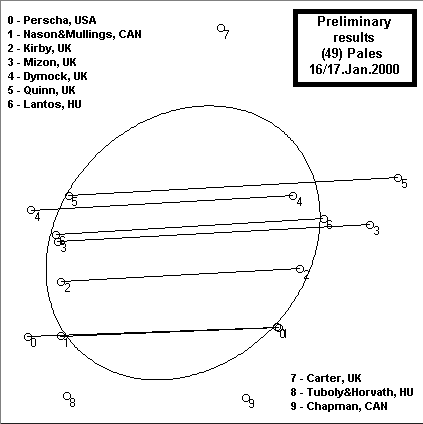
J. Brit. Astron. Assoc., 110, 2, 2000, p.62
The occultation of a 9th magnitude star by the minor planet 49 Pales at 01.00 on Monday January 17 was the first such event to be timed by more than one observer at different locations on the track in the UK (see Figure 1). It was also seen from Hungary, and by three sets of observers in Canada and the USA, but unfortunately heavy cloud prevented observation across most of Europe.

Predictions for the event were provided by Richard Miles on the BAA Web page and also by Jan Manek through the 'Planoccult' mailing list. Four observers in southern England were lucky to be under clear skies and recorded positive events. As shown on the Meteosat chart (Figure 2), a strip of cloud at the wrong moment frustrated three more observers in Surrey and Berkshire. Negative observations were received from further north. Based on the timings reported, Manek has drawn a preliminary profile of the asteroid (Figure 3), and a refined orbit for the object can also be obtained.

Figure 3. Preliminary profile plot of 49 Pales based on the results of the occultation. (Jan Manek, EAON)
Observing these events is remarkably simple, and requires only a small telescope, preferably with manual or digital setting circles, a clock set to accurate UT time, and a stopwatch or timer. More observers are urgently needed to provide a wider spread of possible locations - the predicted track of each event is narrow, so there are only a few likely events per month for any one place. If you have a clear sky and are close to the track, a negative observation is almost as valuable as a positive in helping to define the limits of the asteroid's shadow as it passes across the Earth.
In addition to the listings on the BAA Web page mentioned above, track maps for future events in Europe and the UK may be found at http://www.aula.com/EAON/
 Go to the BAA Journal home page
Go to the BAA Journal home page
Return to Journal 2000 April contents page